Deck 29: The Farm Problem
Question
Question
Question
Question
Question
Question
Question
Question
Question
Question
Question
Question
Question
Question
Question
Question
Question
Question
Question
Question
Question
Question
Question
Question
Question
Question
Question
Question
Question
Question
Question
Question
Question
Question
Question
Question
Question
Question
Question
Question
Question
Question
Question
Question
Question
Question
Question
Question
Question
Question
Question
Question
Question
Question
Question
Question
Question
Question
Question
Question
Question
Question
Question
Question
Question
Question
Question
Question
Question
Question
Question
Question
Question
Question
Question
Question
Question
Question
Question
Question

Unlock Deck
Sign up to unlock the cards in this deck!
Unlock Deck
Unlock Deck
1/117
Play
Full screen (f)
Deck 29: The Farm Problem
1
If an agricultural market is perfectly competitive,which of the following types of behavior might be expected?
A)Price wars.
B)Economic profits encourage entry.
C)Advertising.
A)Price wars.
B)Economic profits encourage entry.
C)Advertising.
Economic profits encourage entry.
2
Which of the following characterizes a competitive agricultural market?
A)The firm has a downward-sloping demand curve.
B)The market has a horizontal demand curve.
C)Price is determined by market demand and market supply.
A)The firm has a downward-sloping demand curve.
B)The market has a horizontal demand curve.
C)Price is determined by market demand and market supply.
Price is determined by market demand and market supply.
3
A bumper crop of apples can lead to sharply lower market prices and a decline in earned farm income primarily because
A)The demand for apples is price-inelastic.
B)Foreign exports of apples to the United States should increase.
C)The income elasticity of demand for apples is negative.
A)The demand for apples is price-inelastic.
B)Foreign exports of apples to the United States should increase.
C)The income elasticity of demand for apples is negative.
The demand for apples is price-inelastic.
4
The price elasticity of demand for food is
A)Perfectly inelastic.
B)Relatively inelastic.
C)Relatively elastic.
A)Perfectly inelastic.
B)Relatively inelastic.
C)Relatively elastic.

Unlock Deck
Unlock for access to all 117 flashcards in this deck.
Unlock Deck
k this deck
5
Individual farmers maximize profit by producing the level of output at which
A)Marginal cost equals average cost.
B)Marginal cost equals zero.
C)Marginal cost equals price.
A)Marginal cost equals average cost.
B)Marginal cost equals zero.
C)Marginal cost equals price.

Unlock Deck
Unlock for access to all 117 flashcards in this deck.
Unlock Deck
k this deck
6
Farmers cannot individually affect market price because
A)There is an infinite demand for their goods.
B)Demand is perfectly inelastic for the farmer's produce.
C)Their individual production is insignificant relative to the production of the market.
A)There is an infinite demand for their goods.
B)Demand is perfectly inelastic for the farmer's produce.
C)Their individual production is insignificant relative to the production of the market.

Unlock Deck
Unlock for access to all 117 flashcards in this deck.
Unlock Deck
k this deck
7
Compared to the early 1950s,today farm output per labor-hour is
A)10 times greater than it was then.
B)The same as it was then.
C)20 times greater than it was then.
A)10 times greater than it was then.
B)The same as it was then.
C)20 times greater than it was then.

Unlock Deck
Unlock for access to all 117 flashcards in this deck.
Unlock Deck
k this deck
8
How much will farm subsidies cost taxpayers between 2002 and 2012?
A)$15-$20 billion per year.
B)$50-$100 billion per year.
C)$500-$800 billion per year.
A)$15-$20 billion per year.
B)$50-$100 billion per year.
C)$500-$800 billion per year.

Unlock Deck
Unlock for access to all 117 flashcards in this deck.
Unlock Deck
k this deck
9
Which of the following is true for a perfectly competitive agricultural market with economic profits?
A)Firms will enter and existing firms will increase their production until economic profits are zero.
B)The profits will last indefinitely since there are barriers to entry.
C)Firms will exit until normal profits are zero.
A)Firms will enter and existing firms will increase their production until economic profits are zero.
B)The profits will last indefinitely since there are barriers to entry.
C)Firms will exit until normal profits are zero.

Unlock Deck
Unlock for access to all 117 flashcards in this deck.
Unlock Deck
k this deck
10
Which of the following is true for the agriculture market?
A)The law of demand does not apply.
B)Individual farmers face a horizontal demand curve.
C)Individual farmers face a vertical demand curve.
A)The law of demand does not apply.
B)Individual farmers face a horizontal demand curve.
C)Individual farmers face a vertical demand curve.

Unlock Deck
Unlock for access to all 117 flashcards in this deck.
Unlock Deck
k this deck
11
The price elasticity of demand for soybeans is defined as the
A)Percentage change in quantity demanded of soybeans divided by the percentage change in the price of soybeans.
B)Percentage change in quantity demanded of soybeans times the percentage change in soybean price.
C)Unit change in soybean price divided by the unit change in quantity demanded of soybeans.
A)Percentage change in quantity demanded of soybeans divided by the percentage change in the price of soybeans.
B)Percentage change in quantity demanded of soybeans times the percentage change in soybean price.
C)Unit change in soybean price divided by the unit change in quantity demanded of soybeans.

Unlock Deck
Unlock for access to all 117 flashcards in this deck.
Unlock Deck
k this deck
12
Because the income elasticity of food demand is low,we expect an increase in income to result in
A)A significant increase in the quantity of food demanded.
B)A very slight increase in the quantity of food demanded.
C)A very slight decrease in the quantity of food demanded.
A)A significant increase in the quantity of food demanded.
B)A very slight increase in the quantity of food demanded.
C)A very slight decrease in the quantity of food demanded.

Unlock Deck
Unlock for access to all 117 flashcards in this deck.
Unlock Deck
k this deck
13
The typically price-inelastic demand for agricultural products can be explained by
A)Increasing opportunity costs.
B)Rapidly diminishing marginal utility.
C)Increasing marginal costs.
A)Increasing opportunity costs.
B)Rapidly diminishing marginal utility.
C)Increasing marginal costs.

Unlock Deck
Unlock for access to all 117 flashcards in this deck.
Unlock Deck
k this deck
14
If an agricultural market is perfectly competitive,then
A)A farmer is a price taker.
B)A farmer practices price discrimination.
C)The market demand curve is perfectly elastic.
A)A farmer is a price taker.
B)A farmer practices price discrimination.
C)The market demand curve is perfectly elastic.

Unlock Deck
Unlock for access to all 117 flashcards in this deck.
Unlock Deck
k this deck
15
In the United States,in general,farmers behave like
A)Monopolists.
B)Oligopolists.
C)Perfect competitors.
A)Monopolists.
B)Oligopolists.
C)Perfect competitors.

Unlock Deck
Unlock for access to all 117 flashcards in this deck.
Unlock Deck
k this deck
16
The exit of farms from a market should
A)Shift the agricultural market supply curve to the right.
B)Increase the equilibrium market price.
C)Decrease the equilibrium market price.
A)Shift the agricultural market supply curve to the right.
B)Increase the equilibrium market price.
C)Decrease the equilibrium market price.

Unlock Deck
Unlock for access to all 117 flashcards in this deck.
Unlock Deck
k this deck
17
If an individual farmer in a perfectly competitive agricultural market raises her price above the market price,the farmer will
A)Not sell any product.
B)Earn greater total revenue.
C)See other farmers follow the price rise.
A)Not sell any product.
B)Earn greater total revenue.
C)See other farmers follow the price rise.

Unlock Deck
Unlock for access to all 117 flashcards in this deck.
Unlock Deck
k this deck
18
In a perfectly competitive farm market with economic losses,farmers will
A)Buy more farmland and expand until profits are normal.
B)Exit until accounting profits are zero.
C)Exit until profits are normal.
A)Buy more farmland and expand until profits are normal.
B)Exit until accounting profits are zero.
C)Exit until profits are normal.

Unlock Deck
Unlock for access to all 117 flashcards in this deck.
Unlock Deck
k this deck
19
Ceteris paribus,if the corn crop is 15 percent larger this year than it was last year,farmers will have to ________ the price of corn by ________ to sell the new crop.
A)raise;more than 15 percent
B)reduce;more than 15 percent
C)reduce;less than 15 percent
A)raise;more than 15 percent
B)reduce;more than 15 percent
C)reduce;less than 15 percent

Unlock Deck
Unlock for access to all 117 flashcards in this deck.
Unlock Deck
k this deck
20
In order to continue earning an economic profit,individual farmers must
A)Expand their rate of output until marginal cost equals zero.
B)Charge higher prices than their competitors.
C)Continue to improve their productivity.
A)Expand their rate of output until marginal cost equals zero.
B)Charge higher prices than their competitors.
C)Continue to improve their productivity.

Unlock Deck
Unlock for access to all 117 flashcards in this deck.
Unlock Deck
k this deck
21
Farm price support programs most often take the form of price
A)Ceilings above the equilibrium price.
B)Floors above the equilibrium price.
C)Ceilings below the equilibrium price.
A)Ceilings above the equilibrium price.
B)Floors above the equilibrium price.
C)Ceilings below the equilibrium price.

Unlock Deck
Unlock for access to all 117 flashcards in this deck.
Unlock Deck
k this deck
22
Which of the following would result from a price support program when the support price is set above the equilibrium price,ceteris paribus?
A)Output would decline.
B)The price paid by consumers would rise.
C)The consumption of the product would rise.
A)Output would decline.
B)The price paid by consumers would rise.
C)The consumption of the product would rise.

Unlock Deck
Unlock for access to all 117 flashcards in this deck.
Unlock Deck
k this deck
23
The biggest plunge in farm prices occurred
A)During WWI.
B)During the Great Depression of the 1930s.
C)After WWII.
A)During WWI.
B)During the Great Depression of the 1930s.
C)After WWII.

Unlock Deck
Unlock for access to all 117 flashcards in this deck.
Unlock Deck
k this deck
24
Which of the following helped to maintain a healthy farm sector prior to 1920?
A)A decreasing population.
B)More advanced technology.
C)Recurrent wars.
A)A decreasing population.
B)More advanced technology.
C)Recurrent wars.

Unlock Deck
Unlock for access to all 117 flashcards in this deck.
Unlock Deck
k this deck
25
Wide price swings in farm products are the result of
A)Supply shifts and the relatively inelastic demand for food.
B)Supply shifts and the relatively elastic demand for food.
C)The high income elasticity of food demand.
A)Supply shifts and the relatively inelastic demand for food.
B)Supply shifts and the relatively elastic demand for food.
C)The high income elasticity of food demand.

Unlock Deck
Unlock for access to all 117 flashcards in this deck.
Unlock Deck
k this deck
26
During the period from 1910 to 1919,demand for U.S.farm goods
A)Increased because of the expanded foreign demand.
B)Increased because of the improved farm technology.
C)Decreased because of the Great Depression.
A)Increased because of the expanded foreign demand.
B)Increased because of the improved farm technology.
C)Decreased because of the Great Depression.

Unlock Deck
Unlock for access to all 117 flashcards in this deck.
Unlock Deck
k this deck
27
Agricultural prices
A)Are being influenced less by international markets than they were 20 years ago.
B)Are lower because government support programs exist.
C)Have fallen relative to nonagricultural prices in the long run.
A)Are being influenced less by international markets than they were 20 years ago.
B)Are lower because government support programs exist.
C)Have fallen relative to nonagricultural prices in the long run.

Unlock Deck
Unlock for access to all 117 flashcards in this deck.
Unlock Deck
k this deck
28
The primary focus of U.S.farm policy has been
A)Subsidies.
B)Price supports.
C)Low-interest loans.
A)Subsidies.
B)Price supports.
C)Low-interest loans.

Unlock Deck
Unlock for access to all 117 flashcards in this deck.
Unlock Deck
k this deck
29
The impact of price supports is to
A)Reduce the market price.
B)Shift the demand curve for each farmer to the left.
C)Increase the output of farmers.
A)Reduce the market price.
B)Shift the demand curve for each farmer to the left.
C)Increase the output of farmers.

Unlock Deck
Unlock for access to all 117 flashcards in this deck.
Unlock Deck
k this deck
30
The relationship between farm and nonfarm prices that existed during the period from 1910 to 1914 is known as
A)The payment-in-kind program.
B)The target price.
C)The farm parity price.
A)The payment-in-kind program.
B)The target price.
C)The farm parity price.

Unlock Deck
Unlock for access to all 117 flashcards in this deck.
Unlock Deck
k this deck
31
Time lags between the production decision and the resultant harvest contribute to
A)Profit.
B)Loss.
C)Price instability.
A)Profit.
B)Loss.
C)Price instability.

Unlock Deck
Unlock for access to all 117 flashcards in this deck.
Unlock Deck
k this deck
32
Suppose European incomes increase annually by 4 percent per year,and as a result,U.S.farm exports to Europe rise by 2 percent annually.The U.S.farm exports are
A)Inferior goods.
B)Normal goods.
C)Price-elastic.
A)Inferior goods.
B)Normal goods.
C)Price-elastic.

Unlock Deck
Unlock for access to all 117 flashcards in this deck.
Unlock Deck
k this deck
33
An effective price floor
A)Results in a surplus.
B)Results in a shortage.
C)Occurs when market prices are below equilibrium prices.
A)Results in a surplus.
B)Results in a shortage.
C)Occurs when market prices are below equilibrium prices.

Unlock Deck
Unlock for access to all 117 flashcards in this deck.
Unlock Deck
k this deck
34
From the early 1900s to 2007,the ratio of farm prices to nonfarm prices
A)Decreased 60 percent.
B)Increased 60 percent.
C)Decreased 25 percent.
A)Decreased 60 percent.
B)Increased 60 percent.
C)Decreased 25 percent.

Unlock Deck
Unlock for access to all 117 flashcards in this deck.
Unlock Deck
k this deck
35
Prices of farm products are
A)Very stable in the short run.
B)Subject to short-term swings.
C)Below the market equilibrium price because of price support programs.
A)Very stable in the short run.
B)Subject to short-term swings.
C)Below the market equilibrium price because of price support programs.

Unlock Deck
Unlock for access to all 117 flashcards in this deck.
Unlock Deck
k this deck
36
If the support price is set below the equilibrium market price,
A)A surplus will result.
B)A shortage will result.
C)The equilibrium price will result.
A)A surplus will result.
B)A shortage will result.
C)The equilibrium price will result.

Unlock Deck
Unlock for access to all 117 flashcards in this deck.
Unlock Deck
k this deck
37
If an agricultural price support keeps a price above the equilibrium market price,
A)Shortages of agricultural products will result.
B)More resources will be devoted to agriculture than are optimal.
C)There will be redistribution of income from the government to consumers.
A)Shortages of agricultural products will result.
B)More resources will be devoted to agriculture than are optimal.
C)There will be redistribution of income from the government to consumers.

Unlock Deck
Unlock for access to all 117 flashcards in this deck.
Unlock Deck
k this deck
38
Suppose European incomes increase by 4 percent per year,and as a result,U.S.exports of farm goods to Europe rise by less than 4 percent annually.The elasticity that can be computed from this information is the
A)Price elasticity of supply.
B)Cross-price elasticity of demand for income with respect to U.S.farm goods.
C)Income elasticity of demand for U.S.farm exports.
A)Price elasticity of supply.
B)Cross-price elasticity of demand for income with respect to U.S.farm goods.
C)Income elasticity of demand for U.S.farm exports.

Unlock Deck
Unlock for access to all 117 flashcards in this deck.
Unlock Deck
k this deck
39
Response lags
A)Reduce short-term price instability.
B)Increase short-term price instability.
C)Slow the long-term downward trend in farm prices.
A)Reduce short-term price instability.
B)Increase short-term price instability.
C)Slow the long-term downward trend in farm prices.

Unlock Deck
Unlock for access to all 117 flashcards in this deck.
Unlock Deck
k this deck
40
If a price support is maintained above the equilibrium price,the result will be a
A)Market price that is too low.
B)Market price equal to the equilibrium price.
C)Surplus of the product.
A)Market price that is too low.
B)Market price equal to the equilibrium price.
C)Surplus of the product.

Unlock Deck
Unlock for access to all 117 flashcards in this deck.
Unlock Deck
k this deck
41
Government subsidies on the purchase of fertilizer by farmers result in
A)Higher fixed costs to farmers.
B)Lower costs of production and increased output.
C)Decreased output because variable costs are higher.
A)Higher fixed costs to farmers.
B)Lower costs of production and increased output.
C)Decreased output because variable costs are higher.

Unlock Deck
Unlock for access to all 117 flashcards in this deck.
Unlock Deck
k this deck
42
The advantage of direct income supports is that they
A)Provide income security without distorting market prices and output.
B)Raise market prices.
C)Increase market output.
A)Provide income security without distorting market prices and output.
B)Raise market prices.
C)Increase market output.

Unlock Deck
Unlock for access to all 117 flashcards in this deck.
Unlock Deck
k this deck
43
Prior to 2001,if the market price of cotton was below the government's loan rate,
A)The cotton farmer received a loan deficiency payment and relinquished the crop to the CCC.
B)The cotton farmer defaulted on the loan but kept the crop;the CCC kept the money.
C)The cotton farmer,in effect,bought the crop from the CCC.
A)The cotton farmer received a loan deficiency payment and relinquished the crop to the CCC.
B)The cotton farmer defaulted on the loan but kept the crop;the CCC kept the money.
C)The cotton farmer,in effect,bought the crop from the CCC.

Unlock Deck
Unlock for access to all 117 flashcards in this deck.
Unlock Deck
k this deck
44
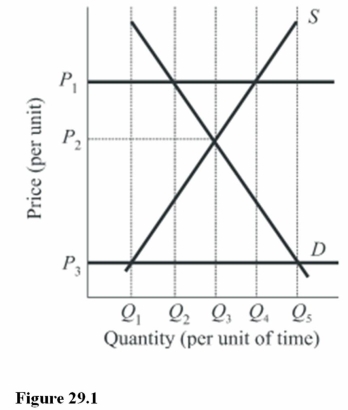 If the government wished to institute a set-aside program to support the price at P1 rather than P2 in Figure 29.1,by how much would market output be reduced?
If the government wished to institute a set-aside program to support the price at P1 rather than P2 in Figure 29.1,by how much would market output be reduced?A)Q5 to Q1.
B)Q3 to Q1.
C)Q3 to Q2.

Unlock Deck
Unlock for access to all 117 flashcards in this deck.
Unlock Deck
k this deck
45
The loan rate is the
A)Interest rate farmers pay banks for loans.
B)Same as the prime lending rate.
C)Implicit price paid by the government for surplus crops.
A)Interest rate farmers pay banks for loans.
B)Same as the prime lending rate.
C)Implicit price paid by the government for surplus crops.

Unlock Deck
Unlock for access to all 117 flashcards in this deck.
Unlock Deck
k this deck
46
The government inflates the demand for farm products
A)By purchasing surplus crops.
B)Through marketing orders.
C)Through acreage set-asides.
A)By purchasing surplus crops.
B)Through marketing orders.
C)Through acreage set-asides.

Unlock Deck
Unlock for access to all 117 flashcards in this deck.
Unlock Deck
k this deck
47
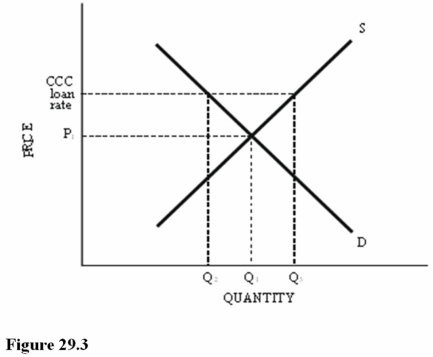
Refer to Figure 29.3 for a cotton market with an equilibrium price of P1 and a Commodity Credit Corporation (CCC)loan rate set above P1.If the CCC loan rate is increased,the
A)Surplus in the market will become larger.
B)Surplus in the market will become smaller.
C)Shortage in the market will become larger.

Unlock Deck
Unlock for access to all 117 flashcards in this deck.
Unlock Deck
k this deck
48
The Agricultural Adjustment Act of 1933 was based on the belief that farm incomes would improve if
A)Parity prices were eliminated.
B)Acreage set-asides were eliminated.
C)Parity prices were restored.
A)Parity prices were eliminated.
B)Acreage set-asides were eliminated.
C)Parity prices were restored.

Unlock Deck
Unlock for access to all 117 flashcards in this deck.
Unlock Deck
k this deck
49
Which of the following can be used to eliminate agricultural shortages?
A)Selling the surplus in government stockpiles.
B)Stimulating export sales.
C)Acreage set-asides.
A)Selling the surplus in government stockpiles.
B)Stimulating export sales.
C)Acreage set-asides.

Unlock Deck
Unlock for access to all 117 flashcards in this deck.
Unlock Deck
k this deck
50
In 2010 how much could a wheat farmer borrow for every bushel of wheat relinquished to the Commodity Credit Corporation (CCC)?
A)$1.95.
B)$2.94.
C)$3.00.
A)$1.95.
B)$2.94.
C)$3.00.

Unlock Deck
Unlock for access to all 117 flashcards in this deck.
Unlock Deck
k this deck
51
Which of the following agricultural programs reduces agricultural output rather than increasing it?
A)Direct income support programs.
B)Marketing orders.
C)Farm cost subsidies.
A)Direct income support programs.
B)Marketing orders.
C)Farm cost subsidies.

Unlock Deck
Unlock for access to all 117 flashcards in this deck.
Unlock Deck
k this deck
52
Irrigation water delivered by federally funded reclamation projects is classified as
A)A farm cost subsidy.
B)Parity prices.
C)An income support program.
A)A farm cost subsidy.
B)Parity prices.
C)An income support program.

Unlock Deck
Unlock for access to all 117 flashcards in this deck.
Unlock Deck
k this deck
53
Which of the following government actions will decrease surplus food supplies?
A)An increase in the loan rate.
B)A decrease in acreage set-asides.
C)Subsidized advertising of U.S.farm products in foreign markets.
A)An increase in the loan rate.
B)A decrease in acreage set-asides.
C)Subsidized advertising of U.S.farm products in foreign markets.

Unlock Deck
Unlock for access to all 117 flashcards in this deck.
Unlock Deck
k this deck
54
Supply restrictions in the farming industry occur in the form of
A)Import quotas.
B)Government stockpiles.
C)Price supports.
A)Import quotas.
B)Government stockpiles.
C)Price supports.

Unlock Deck
Unlock for access to all 117 flashcards in this deck.
Unlock Deck
k this deck
55
Which program forces farmers to destroy millions of dollars' worth of crops each year?
A)Marketing orders.
B)Set-asides.
C)The dairy termination program.
A)Marketing orders.
B)Set-asides.
C)The dairy termination program.

Unlock Deck
Unlock for access to all 117 flashcards in this deck.
Unlock Deck
k this deck
56
Supply restrictions in the farming industry occur in the form of
A)Price supports.
B)Acreage set-asides.
C)Countercyclical payments.
A)Price supports.
B)Acreage set-asides.
C)Countercyclical payments.

Unlock Deck
Unlock for access to all 117 flashcards in this deck.
Unlock Deck
k this deck
57
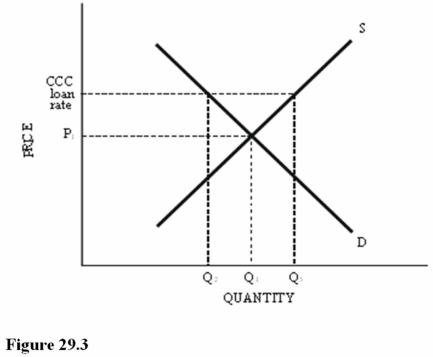
Refer to Figure 29.3 for a cotton market with an equilibrium price of P1 and a Commodity Credit Corporation (CCC)loan rate set above P1.Given this situation,cotton farmers are most likely to
A)Sell their cotton on the market and repay the CCC loan with the proceeds plus other funds to make up the difference.
B)Sell their cotton on the market and repay only a portion of the CCC loan.
C)Give their cotton to the CCC and not repay the loan.

Unlock Deck
Unlock for access to all 117 flashcards in this deck.
Unlock Deck
k this deck
58
According to the text,which of the following items has the U.S.federal government subsidized for farmers?
A)Transportation.
B)Migrant workers.
C)Marketing.
A)Transportation.
B)Migrant workers.
C)Marketing.

Unlock Deck
Unlock for access to all 117 flashcards in this deck.
Unlock Deck
k this deck
59
An advantage of set-aside programs over price support programs is that they
A)Reduce the price of agricultural goods.
B)Transfer more income to farmers.
C)Raise the price of agricultural production but do not lead to a surplus of output.
A)Reduce the price of agricultural goods.
B)Transfer more income to farmers.
C)Raise the price of agricultural production but do not lead to a surplus of output.

Unlock Deck
Unlock for access to all 117 flashcards in this deck.
Unlock Deck
k this deck
60
Parity pricing refers to the relative price of farm products to nonfarm products in the period
A)1930-1944.
B)1985-2004.
C)1910-1914.
A)1930-1944.
B)1985-2004.
C)1910-1914.

Unlock Deck
Unlock for access to all 117 flashcards in this deck.
Unlock Deck
k this deck
61
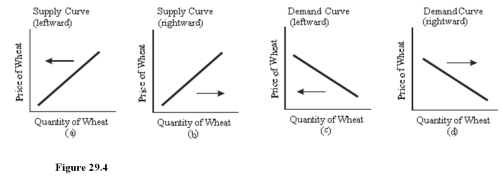
Select the letter of the diagram in Figure 28.1 that best represents the effect of each event on the United States wheat market,ceteris paribus: Relaxed immigration laws lead to lower labor costs.(See Figure 29.4. )
A)a.
B)b.
C)c.

Unlock Deck
Unlock for access to all 117 flashcards in this deck.
Unlock Deck
k this deck
62
The 1990 Farm Act
A)Reduced target prices for farm products.
B)Reduced loan rates.
C)Increased the amount of set-aside acreage.
A)Reduced target prices for farm products.
B)Reduced loan rates.
C)Increased the amount of set-aside acreage.

Unlock Deck
Unlock for access to all 117 flashcards in this deck.
Unlock Deck
k this deck
63
When interest rates rise,the debt burden for farmers
A)Rises and the value of their land falls.
B)Falls and the value of their land falls.
C)Rises and the value of their land rises.
A)Rises and the value of their land falls.
B)Falls and the value of their land falls.
C)Rises and the value of their land rises.

Unlock Deck
Unlock for access to all 117 flashcards in this deck.
Unlock Deck
k this deck
64
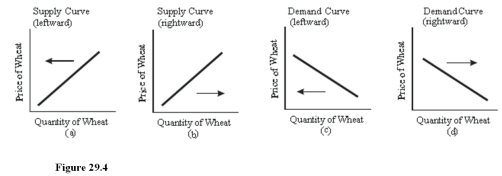
Select the letter of the diagram in Figure 28.1 that best represents the effect of each event on the United States wheat market,ceteris paribus: The dollar increases in value in the foreign exchange markets.(See Figure 29.4. )
A)a.
B)b.
C)c.

Unlock Deck
Unlock for access to all 117 flashcards in this deck.
Unlock Deck
k this deck
65
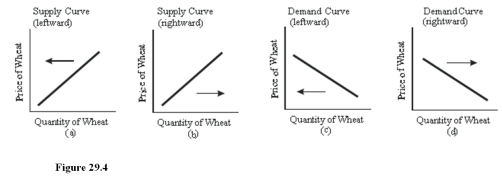
Select the letter of the diagram in Figure 28.1 that best represents the effect of each event on the United States wheat market,ceteris paribus: Transport costs for farm products increase.(See Figure 29.4. )
A)a.
B)b.
C)c.

Unlock Deck
Unlock for access to all 117 flashcards in this deck.
Unlock Deck
k this deck
66
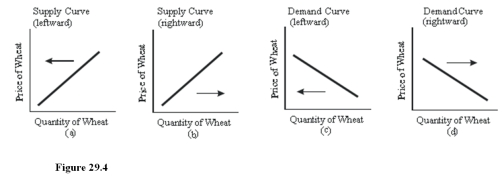
Select the letter of the diagram in Figure 28.1 that best represents the effect of each event on the United States wheat market,ceteris paribus: The European Union tightens restrictions on the agricultural products that can be imported from the United States.(See Figure 29.4. )
A)a.
B)b.
C)c.

Unlock Deck
Unlock for access to all 117 flashcards in this deck.
Unlock Deck
k this deck
67
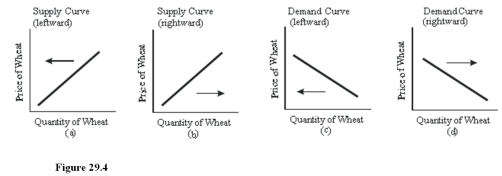
Select the letter of the diagram in Figure 28.1 that best represents the effect of each event on the United States wheat market,ceteris paribus: The federal government decides to no longer purchase wheat from farmers.(See Figure 29.4. )
A)a.
B)b.
C)c.

Unlock Deck
Unlock for access to all 117 flashcards in this deck.
Unlock Deck
k this deck
68
Fertilizer prices tend to
A)Increase with increases in oil prices.
B)Decrease with increases in oil prices.
C)Be countercyclical.
A)Increase with increases in oil prices.
B)Decrease with increases in oil prices.
C)Be countercyclical.

Unlock Deck
Unlock for access to all 117 flashcards in this deck.
Unlock Deck
k this deck
69
When interest rates rise,farm profits
A)Increase because the value of farm assets varies directly with interest rates.
B)Decrease because the value of farm assets varies directly with interest rates.
C)Decrease because interest rates represent a major cost for farm production.
A)Increase because the value of farm assets varies directly with interest rates.
B)Decrease because the value of farm assets varies directly with interest rates.
C)Decrease because interest rates represent a major cost for farm production.

Unlock Deck
Unlock for access to all 117 flashcards in this deck.
Unlock Deck
k this deck
70
The 2007 Farm Act was set to expire in 2012 for all of the following reasons except
A)Farm subsidies are received in 362 of the 435 congressional districts.
B)The economic reasons for subsidies were challenged.
C)The high federal budget deficit called for cuts in farm subsidies.
A)Farm subsidies are received in 362 of the 435 congressional districts.
B)The economic reasons for subsidies were challenged.
C)The high federal budget deficit called for cuts in farm subsidies.

Unlock Deck
Unlock for access to all 117 flashcards in this deck.
Unlock Deck
k this deck
71
When interest rates rise,potential income for farmers ________ and their future income becomes _______.
A)falls;more valuable
B)rises;more valuable
C)falls;less valuable
A)falls;more valuable
B)rises;more valuable
C)falls;less valuable

Unlock Deck
Unlock for access to all 117 flashcards in this deck.
Unlock Deck
k this deck
72
A program of countercyclical payments is best classified as a federal
A)Price support program.
B)Farm cost subsidy.
C)Income support program.
A)Price support program.
B)Farm cost subsidy.
C)Income support program.

Unlock Deck
Unlock for access to all 117 flashcards in this deck.
Unlock Deck
k this deck
73
The Farm Security Act of 1985
A)Gradually increased government support prices.
B)Gradually decreased government support prices.
C)Abruptly increased government support prices.
A)Gradually increased government support prices.
B)Gradually decreased government support prices.
C)Abruptly increased government support prices.

Unlock Deck
Unlock for access to all 117 flashcards in this deck.
Unlock Deck
k this deck
74
The intent of the 1996 Freedom to Farm Act was to accomplish all of the following except
A)Make farmers more dependent on market forces.
B)Increase interest rates charged to farmers.
C)Reduce prices to consumers.
A)Make farmers more dependent on market forces.
B)Increase interest rates charged to farmers.
C)Reduce prices to consumers.

Unlock Deck
Unlock for access to all 117 flashcards in this deck.
Unlock Deck
k this deck
75
When interest rates fall,land values
A)Increase because the profitability of land is inversely related to interest rates.
B)Increase because the profitability of land is directly related to interest rates.
C)Decrease because the profitability of land is inversely related to interest rates.
A)Increase because the profitability of land is inversely related to interest rates.
B)Increase because the profitability of land is directly related to interest rates.
C)Decrease because the profitability of land is inversely related to interest rates.

Unlock Deck
Unlock for access to all 117 flashcards in this deck.
Unlock Deck
k this deck
76
An increase in the value of the U.S.dollar internationally,ceteris paribus,would result in
A)Higher revenues for U.S.farmers.
B)An increase in the dollar value of U.S.farmland.
C)Lower revenues for U.S.farmers.
A)Higher revenues for U.S.farmers.
B)An increase in the dollar value of U.S.farmland.
C)Lower revenues for U.S.farmers.

Unlock Deck
Unlock for access to all 117 flashcards in this deck.
Unlock Deck
k this deck
77
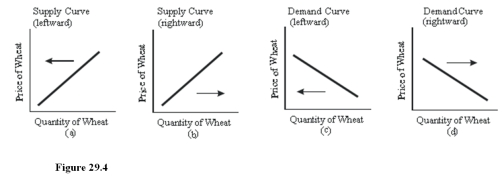
Select the letter of the diagram in Figure 28.1 that best represents the effect of each event on the United States wheat market,ceteris paribus: The federal government restricts the amount of agricultural products that can be imported.(See Figure 29.4. )
A)a.
B)b.
C)c.

Unlock Deck
Unlock for access to all 117 flashcards in this deck.
Unlock Deck
k this deck
78
Farming profits fell between 1979 and 1983 because of all of the following except
A)Declining land values.
B)Rising interest rates.
C)Increasing exports.
A)Declining land values.
B)Rising interest rates.
C)Increasing exports.

Unlock Deck
Unlock for access to all 117 flashcards in this deck.
Unlock Deck
k this deck
79
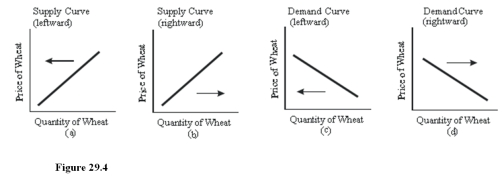
Select the letter of the diagram in Figure 28.1 that best represents the effect of each event on the United States wheat market,ceteris paribus: A bumper wheat crop in Russia results in large imports of wheat to the United States.(See Figure 29.4. )
A)a.
B)b.
C)c.

Unlock Deck
Unlock for access to all 117 flashcards in this deck.
Unlock Deck
k this deck
80
The principal cause of a third farm depression beginning in 1997 was
A)A crop failure in 1998.
B)The Asian economic crisis.
C)A decrease in grain prices.
A)A crop failure in 1998.
B)The Asian economic crisis.
C)A decrease in grain prices.

Unlock Deck
Unlock for access to all 117 flashcards in this deck.
Unlock Deck
k this deck



